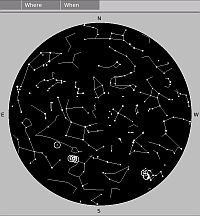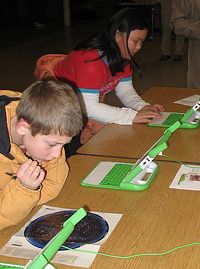I am Dave Wallace and I like to do visual astronomy and night sky photography while traveling.
For this purpose, a full-blown planetarium program with its ability to show telescopic views, invisibly-dim objects and control telescopes was overkill. What I wanted was simply a program for the XO laptop that could answer the question:
"What's overhead next week and 5000 miles from here?"So my StarChart Activity was designed with those requirements in mind.
Design:
The program's catalog is small on purpose: If you're limited to the Mark One Human Eyeball, keeping track of all the stars in the Tycho catalog is way overkill. So my catalog only contains data for the 1800 brightest stars, the moon, the sun and six of the planets.
Setting the time for some other location or for some future or past instant requires that the user enter the time and zone offset -- this avoids having the program try to predict the correct time zone. "Right now" is easier, so I have the option of plotting the sky as of "now" (and updating the plot once a minute).
Setting location can be very approximate for a whole-sky chart. Knowing your location to within a couple of degrees of latitude and longitude is more than sufficient. I allow several options with respect to display color, provide the ability to show the chart in "star chart traditional" (east on the left) or "map" (east on the right) orientation, show or hide the constellation stick-figures and let the user choose how many stars to plot by their brightness.
Planned Improvements:
The ability to share the activity data is not currently implemented. And I want to re-format the toolbars so all controls are still visible when the screen is rotated. Those two additions will complete "version one".
For version two, I'm tempted to extend the program to make it useful for an observer with binoculars. This means the observer has both magnification and greater light-gathering capability than the program is currently set up for. So I'd need to add the ability to show just a selected, small patch of the sky on demand and I'd have to show dimmer objects.
The catalog would therefore have to include about 10,000 more stars and represent the brighter Deep Sky Objects. I'd also like to be able to show the name of a selected star and of its constellation. This would be a teaching aid.
Educational Use:
Besides being an aid for viewing the night sky, the star chart can show how the sky looks from somewhere else and/or at some other time. You can demonstrate what it means to live on a round, rotating planet.
You can show that the sky moves one way as the year progresses while the moon moves the other at about 13 times the rate. You can show how the planets seem to move roughly in the same path. You can even show that the moon will occult the planets and eclipse the sun. Even if your inside
I suppose it even could be used to teach Python programming for the XO. At least it helped me learn to do it! You can read about my adventures in programming the StarChart Activity on the OLPC News Forum.




This is a great Activity. Thank you Dave.
Great work. I believe teaching astronomy can in many ways be used to teach the whole idea of science. First it's stargazing, something everyone does and it's beautiful, then you have to ask yourself what is going on and come up with theories explaining them and seeing if it fits reality. By wathcing the movements of stars from different parallels is how the first civilizations got the idea that the world was round. By trying to explain the movements of the planets they found out they were probably rotating around the sun. It's a wonderful and rich tool. For this I really recommend you allow a simple option to lot the movements of the stars, so you can see their path around the sky every year.
As a side note, i remember reading somewhere that using a bright white light (like a computer monitor) was terrible at stargazing because it ruins your night vision when you look at the laptop and then back to the stars, and a nice soluiton to this was using red light (that for some reason it did not mess you night vision). You could consider testing an optional red & black display option to see if it hold true.
Nice work and nice activity. Along the same lines of educating kids on the sky, there is another activity called Moon[ http://wiki.laptop.org/go/Moon ]. More great stuff for the budding star gazers out there.
Way cool! Many years ago, when I was in teachers' college in Uruguay going for a degree in Astronomy (Astronomy used to be mandatory for all 10th graders in 'guay - maybe still is), with the help of several students that did the data entry I ran a star chart printing program in Apple LOGO on a IIe, output on a dot-matrix. It had a database of 6.000 stars. The program calculated spherical X-Y positions for printing on paper from RA and Alt that we copied from some catalog. Never managed to publish beyond a few samples of my Star Map, but do feel very happy someone is getting this on a grander scale, on a great-grand-child of the ideas that were also behind LOGO.
@Alexander: use some red cellophane to cover the monitor, the kind used for Valentine's day flower bouquets, or maybe output as red "stars" on a black background. In those 'guay days we used such cellophane to cover flashlights for that purpose of preserving night vision.
As an armchair astronomer myself, this is a neat bit of software.
One direction I would explore is localised settings for the IAU constellation names. e.g. "Canis Majoris", "The Greater Dog" (using English as an example, with the latin name perhaps optional?)
One step further, as part of the localisation process, perhaps people could compile local constellation maps according to the local traditions.
P.S. Minor nitpick, second last paragraph link text "Even if your inside" should be "Even if you are inside" or "Even if you're inside".
Dave is already a step ahead of you... there is a night option, turning the screen red/black.
I have witnessed first-hand how quickly the kids eat up StarChart.. they loved it.
Nice work Dave, keep it up.
Clear Skies!
David, Star Chart is a fantastic activity. I never realized how great it was until I showed it to some Nepali kids and watched them fall in love w/ it. When we get some free time we intend to translate it. Is it in Pootle yet?
Keep up the great work David.
The program is not yet internationalized, as I need a tutorial on how to make proper use of gettext and what files go where (I'd love to see a "hello world" example that shows how to go from working code to internationalized working code.)
As Steve found out, I've thought of the night vision issue. Some of the other things (like animating change in time or change in position) are in my "future features" list, too.
Something that will happen soon: I'm going to separate the catalog data out from the code so that it will be possible to load alternate constellation maps, for example, and so that alternate star name sets can be produced. I'm afraid that pootle isn't quite up to the task -- unless somebody can educate me.
I'll bet the Nepali kids with whom Bryan has shared Star Chart (or for that matter the kids in mountainous Peru) have observing conditions that would make a professional astronomer turn XO green with envy. What those kids don't yet have and what the folks reading OLPCNews could help give them is a rich bundle of localized content on the sciences (including astronomy) that can fan the flames of that excitement into a lifelong passion. Who can say, Dave's work might even launch the career of the next Carlos Sagan, but it would help if there were a collection of content to go along with the activity in a junior Astronomy 101 bundle.
There is sure to be great stuff available under suitable licensing on the NASA site (most "US Government works" are public domain at birth), and Dave has certainly got his hands full with sheparding Star Chart along, so how about you, dear reader. What stargazer out there is willing to take the time to paste a few links from their personal bookmarks over to the OLPC wiki http://wiki.laptop.org/go/Science#Astronomy that would help a child learn something about the universe? That's just the first step, but to quote what someone meant to say once, "One small step for a man, one giant leap for mankind". Consider the possiblilty that your skills and abilities may have been developed under a share-alike license between you and the cosmos, thank your lucky stars and think of what you can do to give something back.
Before any one makes the obvious point, I'm not just cheering from the sidelines, I'm doing what I have the skills and passion to do on health-related content, but I'd love to see work move ahead in the rest of the science content development effort. Keep on coding Dave. Those who haven't made the effort to light a candle and would prefer to curse the darkness and point out deficiencies of OLPC organization or progress-to-date or whatever, can save their keystrokes, I'll not be taking the bait, I've got better things to do, like trying to get world-class health content to Bryan's kids in Kathmandu. Being able to share in the overall effort with folks like Dave (and play with the cool things they make) is just part of the fun.